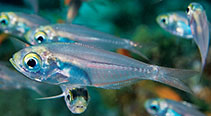| Diagnosis: |
Dorsal spines (total): 6-6; Dorsal soft rays (total): 9-9; Anal spines: 3-3; Anal soft rays: 22-23. This species is characterized by the following: D VI,9; A III,22 (22-23); pectoral-fin rays 17 (16-17, modally 17); lateral-line scales 67 (64-68); scale rows above lateral line to base of dorsal fin 5.5; gill rakers 25 (25-26); body depth 3.1 (3.1-3.15) in SL, width 2.35 (2.2-2.35) in body depth; depth of caudal-peduncle 10.1 (9.5-10.2) in SL; head length 2.85 (2.75-2.8) in SL; snout length 13.2 (12.0-13.0) in SL; relatively large eye, orbit diameter 6.9 (6.7-6.8) in SL with interorbital width 12.2 (11.7-12.1); mouth forming an angle of about 65° to horizontal axis of body; mouth when fully close has the lower jaw slightly protruding; upper jaw with 2 irregular rows of slender, recurved teeth with those of the upper row initially in the same plane as the surface of upper lip, then sharply curved inwardly and posteriorly, while the inner row of teeth are more sharply recurved, teeth continue in two rows. progressively smaller, nearly to end of jaw, before reduced to a single row; lower jaw with a row of slightly smaller, strongly recurved slender teeth; vomer with small, incurved, sharply conical teeth in a single irregular V-shaped row, similar in a row on palatines; thin lips, with very small, well-spaced, dark purple papillae; tongue broadly triangular, indented slightly on sides anteriorly to form a small, rounded, thickened tip; predorsal length 2.45 (2.4-2.45) in SL; first dorsal-fin soft ray longest, 4.7 (broken & 4.8) in SL; caudal-fin forked, fin length 4.35 (4.05-4.1) in SL; pectoral-fin length 3.4 (3.1-3.15) in SL; prepelvic length 2.6 (2.55-2.7) in SL; pelvic fins far from anus, the fin length 5.0 (5.35-5.7) in SL; preanal length 1.55 (1.5-1.6) in SL; without a pin-like dark line anterior to anus; black iris in preserved holotype (Ref. 107896). |

